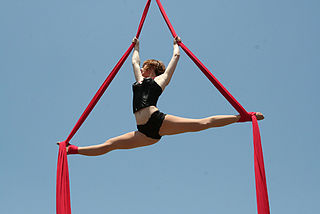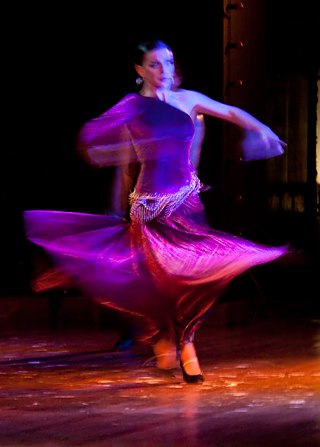
Trampolining or trampoline gymnastics is a competitive Olympic sport in which athletes perform acrobatics while bouncing on a trampoline. In competition, these can include simple jumps in the straight, pike, tuck, or straddle position to more complex combinations of forward and/or backward somersaults and twists. Scoring is based on the difficulty and on the total seconds spent in the air. Points are deducted for bad form and horizontal displacement from the center of the bed.

Acrobatics is the performance of human feats of balance, agility, and motor coordination. Acrobatic skills are used in performing arts, sporting events, and martial arts. Extensive use of acrobatic skills are most often performed in acro dance, circus, gymnastics, and freerunning and to a lesser extent in other athletic activities including ballet, slacklining and diving. Although acrobatics is most commonly associated with human body performance, the term is used to describe other types of performance, such as aerobatics.

A somersault is an acrobatic exercise in which a person's body rotates 360° around a horizontal axis with the feet passing over the head. A somersault can be performed forwards, backwards or sideways and can be executed in the air or on the ground. When performed on the ground, it is typically called a roll.
Trampolining terms are used to describe various positions and types of skill performed in the sport of trampolining.

A cartwheel is a sideways rotary movement of the body. It is performed by bringing the hands to the floor one at a time while the body inverts. The legs travel over the body trunk while one or both hands are on the floor, and then the feet return to the floor one at a time, ending with the athlete standing upright. It is called a cartwheel because the performer's arms and legs move in a fashion similar to the spokes of a turning (cart) wheel.

A handspring is an acrobatic move in which a person executes a complete revolution of the body by lunging headfirst from an upright position into an inverted vertical position and then pushing off from the floor with the hands so as to leap back to an upright position. The direction of body rotation in a handspring may be either forward or backward, and either kind may be performed from a stationary standing position or while in motion.
A flashkick is a type of back flip that is performed in the martial art of tricking, usually performed with one leg extended and the other tucked. As with many other types of back flips, a flashkick may be started from a stationary standing position or immediately following another similar move, such as a roundoff.

The flare is an acrobatic move in which the performer alternates balancing the torso between either arm while swinging the legs beneath in continuous circles. It is a fundamental b-boying/bgirl power move, and in gymnastics it may be performed on a pommel horse or during the floor exercise. The move is commonly spelled flair in gymnastics and further may be called a "Thomas flair" after its originator, Kurt Thomas.

A kip-up is an acrobatic move in which a person transitions from a supine, and less commonly, a prone position, to a standing position. It is used in activities such as breakdancing, acro dance, gymnastics, martial arts, professional wrestling, and freerunning, and in action film fight sequences.

Yurchenko, also known as round-off entry vaults, are a family of vaults performed in artistic gymnastics in which the gymnast does a round-off onto the springboard and a back handspring onto the horse or vaulting table. The gymnast then performs a salto, which may range in difficulty from a simple single tuck to a triple twist layout. Different variations in the difficulty of the salto lead to higher D-scores. This family of vaults is the most common type of vault in gymnastics and is named after Natalia Yurchenko, who first performed it in 1982.

Static trapeze, also known as fixed trapeze, is a type of circus apparatus. In contrast to the other forms of trapeze, static trapeze the bars and ropes mainly stay in place.
A gainer is the acrobatic trick of performing a backwards somersault while still moving forward. In diving, this is known as reverse rotation. Many stunt performers and martial artists are capable of performing a similar skill on the ground, sometimes in combination with a midair inverted kick.

A front aerial is an acrobatic move in which a person executes a complete forward revolution of the body without touching the floor. Front aerials are performed in various physical activities, including acro dance and gymnastics. The front aerial is known by other names, including aerial walkover, front aerial walkover, front flip and front somersault.
This is a general glossary of the terms used in the sport of gymnastics.

An acrobatic flip is a sequence of body movements in which a person leaps into the air and rotates one or more times while airborne. Acrobatic flips are commonly performed in acro dance, free running, gymnastics, cheerleading, high jumping, tricking, goal celebrations, and various other activities. This contrasts with freestyle BMX flips, where a person rotates in the air along with a bicycle.

In dance and gymnastics, a turn is a rotation of the body about the vertical axis. It is usually a complete rotation of the body, although quarter (90°) and half (180°) turns are possible for some types of turns. Multiple, consecutive turns are typically named according to the number of 360° rotations.
A roll is the most basic and fundamental skill in gymnastics class. There are many variations in the skill. Rolls are similar to flips in the fact that they are a complete rotation of the body, but the rotation of the roll is usually made on the ground while a flip is made in the air with the hips passing over the head and without any hands touching the ground. Rolls also help recover from a fall safely.

Aú is the capoeira term for a cartwheel. The purpose of the "aú" in capoeira includes mobility, offense and evasion. The aú has similarity to handstand in capoeira (bananeira), but it differs because the body rotates laterally with an energetic impulse.












